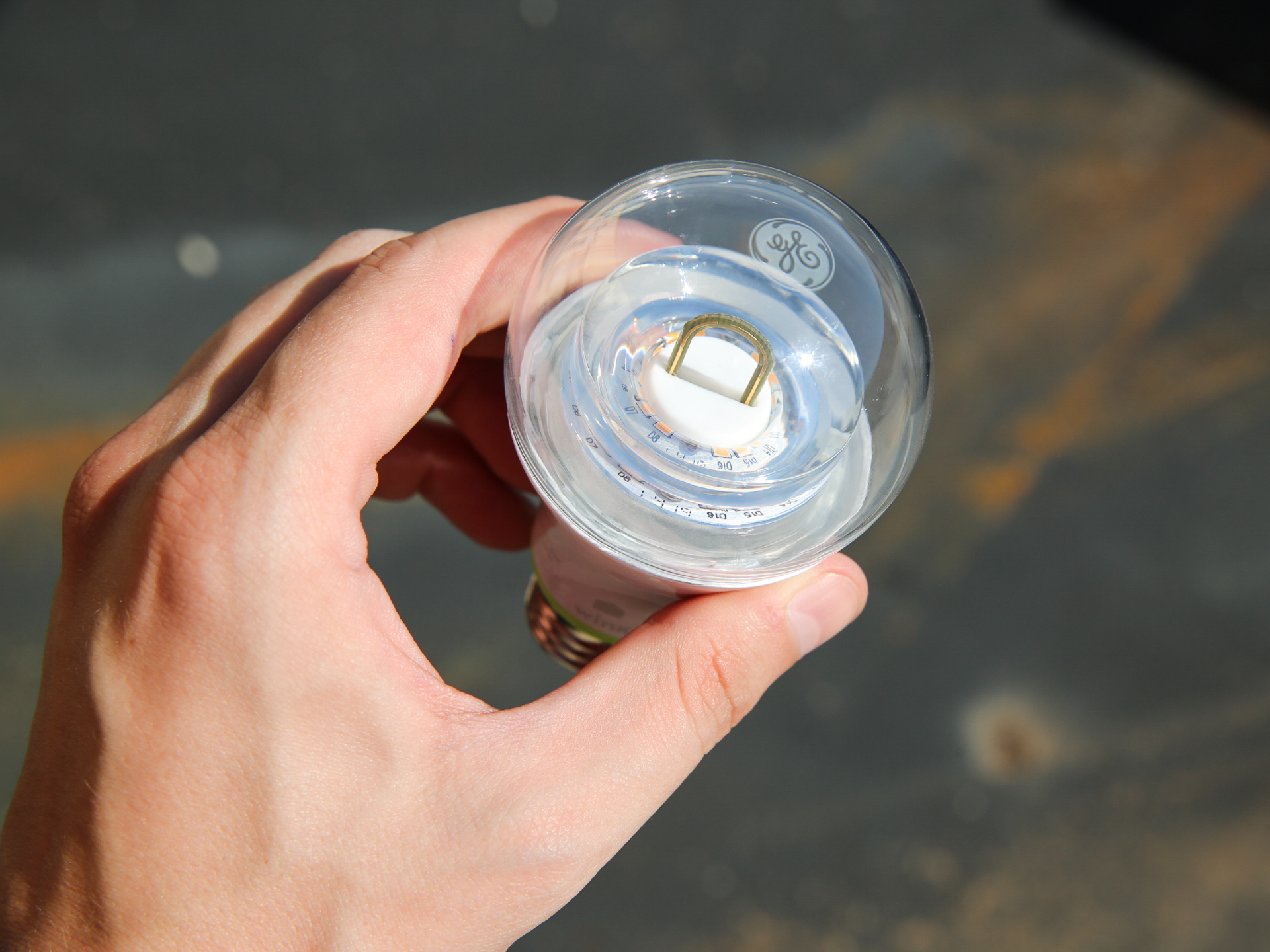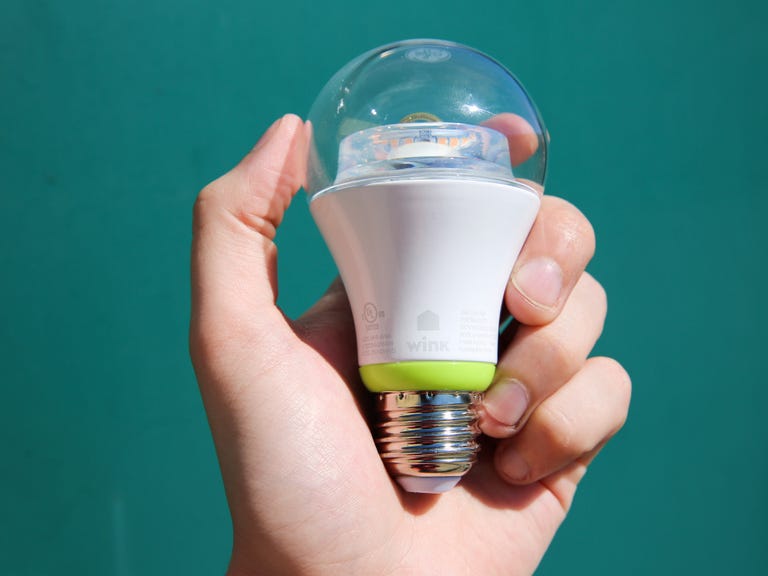 Why You Can Trust CNET
Why You Can Trust CNET GE Link Connected LED review: The price is right for GE's smart bulb
GE's Link LED offers a full range of smart features, and costs just $15 per bulb.
If you need evidence of the rapid evolution we've seen in both the lighting and smart home markets, look no further than the GE Link LED. With Zigbee-powered wireless smarts built right in, each bulb costs just $15. A year ago, that would have been a fair deal for one of its non-connected counterparts.
The Good
The Bad
The Bottom Line
The Link LED is built to integrate into Wink's emerging smart home platform, which means it'll work with other Wink-approved gadgets -- a fairly wide lineup including the likes of Quirky, Dropcam , Honeywell , Lutron , and even competing smart bulbs from TCP and Philips Hue . Couple that with the low cost of the Wink Hub that controls it all, and you're looking at a pretty compelling foundation for the smart home.
That said, I'm not convinced that Wink is ready for primetime. Product after product, we've come away with the same complaint: glitchy software. Despite getting some things right, the Link LEDs were no exception, causing plenty of headaches during the testing process. There's still a lot to like about them, and at that price point, I think you can definitely afford to try one out. However, I also think I'd wait for Wink to polish the user experience a bit more before buying in too heavily.

Performance and design
GE's Link LED isn't designed to blend in with the bulbs that came before it. With its clear globe and exposed hardware, it makes no attempt to pass itself off as an ordinary light, which is the recent approach we've seen many LED competitors take. Even compared to other smart LEDs like the Philips Hue Lux , the Connected by TCP LED , and the Belkin WeMo LED , the GE Link is the bulb that looks the most conspicuous.
Like those other smart options, the GE Link promises to last 25,000 hours, and offers around 800 lumens of light output at a warm, yellowy color temperature. GE gets there using 12 watts, which is slightly less efficient than the competition, but still a worthy upgrade over incandescents.
| GE Link LEDs | Connected by TCP LEDs | Philips Hue Lux LEDs | Belkin WeMo LEDs | |
|---|---|---|---|---|
| Lumens | 800 | 800 | 750 | 800 |
| Watts | 12 | 11 | 9 | 9.5 |
| Efficiency | 67 lumens/watt | 73 lumens/watt | 83 lumens/watt | 84 lumens/watt |
| Color temperature (stated) | 2,830 K (2,700 K) | 2,603 K (2,700 K) | 2,640 K (2,700 K) | 3,058 K (3,000 K) |
| Lifespan | 25,000 hours | 25,000 hours | 25,000 hours | 25,000 hours |
| Color Rendering Index | 90 | 80 | 79 | 88 |
| Dimmable Range | 10.2 - 100% | 1.2 - 100% | 0.5 - 100% | 3.8 - 100% |
| Remote | No | Yes ($20) | Yes ($60) | No |
| Bulbs per kit | 2 | 2 | 2 | 2 |
| Price per bulb | $15 | $20 | $30 | $30 |
| Price per kit | $50 | $80 | $100 | $100 |
Something else the GE Link LED shares with its competitors is smart dimming capabilities, which simply means that you'll be able to dial the light up and down through the Wink app. However, the Link LED doesn't dim down quite as far as the others, which were able to get as low as 0.5 percent of initial brightness before shutting off. We couldn't get the Link LED down any lower than 10 percent, which was a bit disappointing. I also noticed more lag than the competition as I dimmed the light up and down.
In other basic spec tests, the Link LED did much better, most notably in our color rendering tests. In front of our spectrometer, the Link LED registered a very impressive score of 90 out of 100. A high score like that means that the GE Link LED will illuminate colors more accurately and vividly than much of the competition.
The Link LED offers outstanding color rendering for the price.
That score of 90 is better than any other smart LED we've tested, and just a few points shy of the LEDs that sit atop our color rendering leaderboard, the Cree TW Series LED and the Editors' Choice-winning GE Reveal LED floodlight . Neither of those bulbs is smart, and the GE Link LED costs less than both of them.
The bottom line is that the GE Link's lighting specs are surprisingly good given how much you'll pay for it. If you took the smarts out, it would still be a fairly competitive 60W replacement LED.
The Wink app won't let you dim the light down any lower than 10 percent.
Smart features
Still, lighting specs are only half of the story here. The GE Link is built to compete with other connected LEDs, so you'll want to be sure and factor in the smart features and the usability of the app before making a buying decision.
To access those smart features, you'll need one of three hubs to act as translator between your phone's Wi-Fi and the bulb's Zigbee. Your first option is the Link Hub, a small $30 device that simply plugs into a spare socket, then talks to the bulbs and nothing else. Next up is the Wink Hub , a $50 gadget with additional radios built in, allowing it to control more than just your lighting. Finally, there's the soon-to-be-released Wink Relay , a futuristic, Android-powered touchscreen wall panel that'll sell for $300.
Getting to this screen was more frustrating than it should have been.
GE offers a Link LED starter kit with two bulbs and the Link Hub for a total of $50, which is half of what you'll spend on comparable two-bulb kits from Belkin and Philips. In addition, for a limited time, Home Depot is offering $30 off the price of the Wink Hub when you buy two Link LEDs, essentially giving you a starter kit with an upgraded hub at that same, accessible $50 price point.
Once you're up and running with your hub of choice, you'll connect your Link LEDs by screwing them in and turning them on when the Wink app tells you to. This sounds easy, but it took me multiple tries before the bulb registered. I tried again, this time with a different Wink Hub, and again, pairing things up was a bit of pain, and certainly more tedious than it should have been.
The Wink App offers simple controls for each bulb, with a button to turn the light on or off and a slider bar to dim the light up and down. You'll also be able to combine multiple bulbs into a group, allowing you to control all of them at once.
Beyond remote control of your lights, the Wink app offers automation, too. This starts with basic scheduling -- you can program the lights to turn on and off at various times of the day, and view your lighting schedule on a calendar. When I tested Wink's scheduling out, it never failed to turn the light on or off when it was supposed to.
Your other automation option is to use what Wink calls "Robots," which are simply recipes that tie your lighting to an external trigger. The first one I tested was a proximity command. Wink monitors your phone's location, and can automatically turn the lights on and off as you come a go, a feature called "geofencing."
The Quirky Aros Smart Air Conditioner, another Wink product, offers geofencing, too, but we couldn't ever get it to work when we tested the thing out. Fortunately, the Link LEDs fared much better, successfully turning off whenever I'd leave the office, then turning on again right as I'd pull back into the parking lot.
Wink's Robots can also tie your lighting to other Wink-friendly products. I tested this out with the Quirky Spotter Multipurpose Sensor, telling Wink to turn the lights on whenever the Spotter detected motion, then back off when the motion stopped. I wasn't too impressed with the Spotter when I first reviewed it, but it did the job in this test, reliably turning the light on whenever I walked past it, then back off when I was gone. That made for two signs of improvement from Wink.
However, at this point, the Link LED began to glitch on us. Immediately after deleting those two motion sensing robots in the app, the light began alternating between full brightness and minimum brightness every thirty seconds or so, and stopped responding to my attempts to control it from the app. Even after unscrewing it and then screwing it back in, I couldn't control the thing.
My only option was to delete the Link LED from the system, then add it back in. That'd be especially frustrating if I had already programmed a good deal of robots, as I'd be forced to enter them all back into the app.
I wondered if maybe I was missing a firmware update somewhere, and sure enough, the Wink app was telling me that I needed to update the Hub. I told it to go ahead and do so, but then several minutes later, seemingly still in the middle of the update, the app reverted back to the beginning of the process, telling me an update was available. I wasn't sure if it had cancelled my update, or if there were simply more than one, so I started the process again. The same thing happened again. And then again. And then again on a different device.
None of this is to say that Wink is unusable, but it can definitely be frustrating -- certainly more so than Belkin, TCP, or Philips Hue. If you're willing to put up with that, though, the smart features are actually pretty sharp.
The bottom line
GE's Wink-ready Link LEDs have a lot going for them. At their core, they offer strong light quality, with a fairly exceptional color rendering score. Add in the smart scheduling, geofencing, and compatibility with other Wink products, and you've got a $15 bulb that looks like a potential best buy.
Still, you aren't just buying the bulb -- you're buying into Wink's smart home platform. Though appealing and affordable, it's a wobblier platform than others, with glitches and app crashes that compromise an otherwise appealing user experience. I like these bulbs, but if you wanted to wait for Wink to work its kinks out before buying them, I wouldn't blame you.


